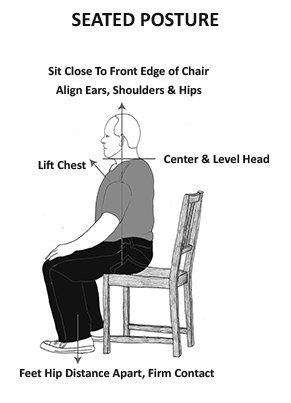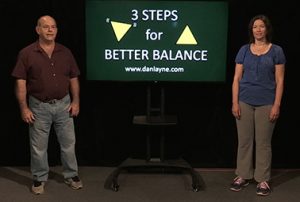 |
 |
 |
Chair Series
The videos on this page are designed to be done in a chair but of course standing is fine as well. Follow along according to your capacity. Avoid forcing when there is discomfort or pain. If you are new to this sort of activity, take it easy, breathe, and enjoy!
Setup

These are basic guidelines. Strive for a sense of ease in your posture and movements.
There are many types of chairs. Simple tends to work best. There is more freedom to move if there are no arms on the chair but many people need them in order to get up safely. The seat, padded or unpadded, should be level or close to level. Seek out a position that is reasonably comfortable. The posture should be as close to vertical as the body will permit without forcing. It helps to have the hips at least level with the knees or slightly higher.
If you are in a wheel chair or using an arm chair, simply adjust your movements as needed by making them smaller when necessary. Strive for a relaxed quality in the body and keep your movements comfortably moderate. If fatigue sets in, stop and rest. Standing and stretching gently upward may help to alleviate postural fatigue.
The diagram to the right illustrates basic postural guidelines for a seated practice. The idea is to be as independent in the posture as possible through minimum use of the chair back. Try to sit close to the front edge of the chair so that most of the thigh is off of the chair seat. Adjust the space between the feet to hip distance and keep the feet flat. Lift the chest gently and don’t force. Align ears and shoulders with the hip sockets. Center and level the head.
These are only guidelines. Adjust, modify, do whatever you need to do in order to be able to work along with the videos.
Sequences:
Since these videos were produced outdoors, there is a little wind, a few ducks, an occasional cawing crow, and few other “ambient” sounds. ENJOY!
SEATED TAI CHI (10:57)
This sequence begins with relaxed breathing, progresses through a gentle limbering warm-up, and then finishes with the first eight patterns of the “Twenty Four Step tai chi chuan routine. Keep the hands soft and relaxed. Slightly spread the fingers and allow the thumbs to open.
PEACE AND RELEASE – A Guided Relaxation (4:45)
This offering for relaxation and stress reduction is generously shared by my colleague Genevieve Shabandar. Genevieve is a survivor with extensive first hand experience in pain management and stress reduction. The emphasis in this presentation is on lowering tension and stress in the body with extra focus on the head and neck.
SEATED TAI CHI #2 (12:59)
This sequence begins with a Relaxation, moves through the Eight Treasures, and finishes with Tensho.
LIMBER AND RELAX – A Guided Relaxation (5:45)
This video, guided by Genevieve, provides a gentle limbering and relaxation sequence that focuses exclusively on the head and neck.
SEATED TAI CHI #3 (5:45)
This video takes us through all twenty four of the movements associated with Yang style short form.
SEATED TAI CHI COMPOSITE (25:20)
This comprehensive practice is composed of:
- Warm-up
- Eight Treasures
- Tensho
- Twenty Four Elements (steps)
- Relaxation







